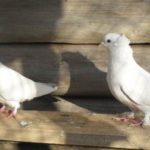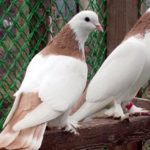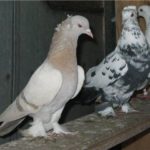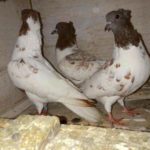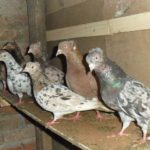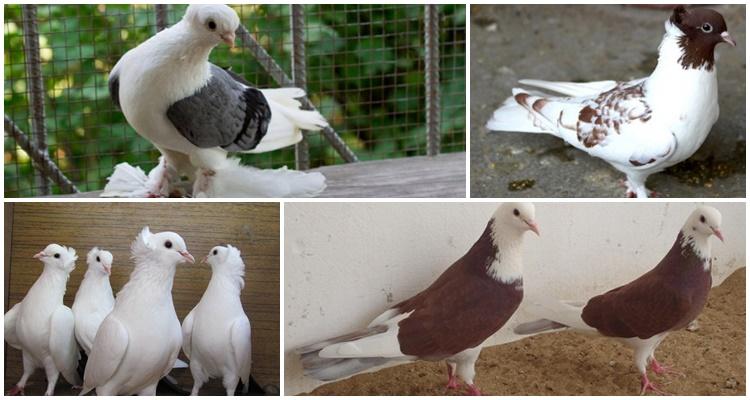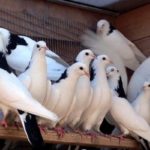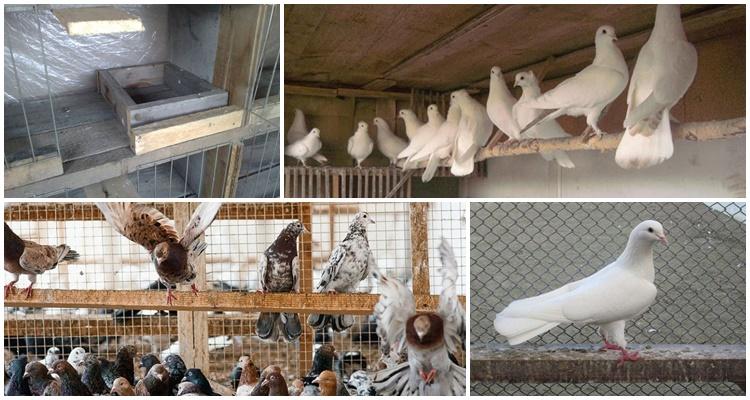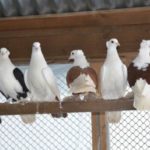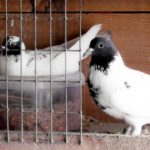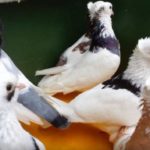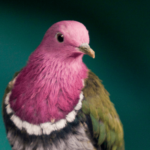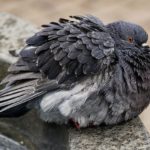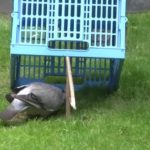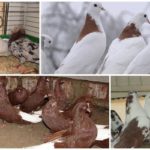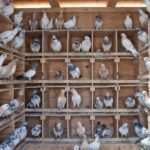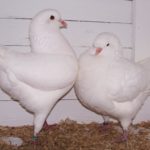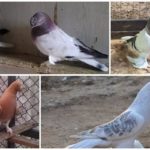Every dovecote owner knows Baku high-flying pigeons, famous for their endurance, exciting games in flight, and unpretentiousness in their maintenance. The term “fighting” is not equal to the concept of “fighting”. The pigeon breed is not intended for fighting, it is decorative, adapted for performing exciting tricks. Its representatives, when playing in the air, “beat” their wings, that is, they make a flapping sound.
- Origin of Baku people
- Exterior of a bird
- Advantages and disadvantages
- Types of Baku slaughterhouses
- Flight Features
- Basic rules of training
- Rules of maintenance and care
- Dovecote size
- Temperature, ventilation
- Perches and nests
- Drinking bowl, feeding trough, bathing bowl
- Litter and cleanliness requirements
- Letok
- Diet planning
- About proximity to another bird
- How to treat Baku residents
Origin of Baku people
The Persians also bred fighting pigeons. Initially, the northern regions of Azerbaijan were Iranian lands; at the beginning of the 19th century they became part of the Russian Empire. In this area, pigeons that are similar in appearance to the modern breed began to be bred in the 1950s. The first fighting birds were unattractive, with a humpbacked body and short limbs.
When pigeons were brought to Baku, local poultry farmers developed the current breed. Several generations of Azerbaijani breeders carefully bred birds and considered them their pride. Today the Baku breed is widespread throughout Russia, and is especially popular in the Caucasus region.
Exterior of a bird
Baku pigeons are not large, but strong, harmoniously built. A description of the breed is given in the table.
| Head | Elongated, the frontal and occipital parts are rounded, the crown is flattened, the crown may be decorated with a forelock |
| beak | straight, thin, slightly curved at the end, white, about 2.2 cm long, with a smooth, weakly defined cere (base) |
| torso | strong, elongated, fusiform, with well-developed muscles, smoothly tapering from the shoulder girdle to the tail, the neck is short, slightly curved |
| wings | long, lie tightly on the body, flight feathers are connected on the tail |
| tail | closed, neat, tail feathers up to 16 pieces |
| limbs | naked or densely covered with short feathers, red skin, translucent white claws |
| plumage | voluminous, dense, smooth and evenly lying feathers, the neck has a purple tint |
| colors | varied, solid and variegated; in terms of flight performance (height and duration), white individuals are considered the best |
Advantages and disadvantages
Before owning Baku pigeons, the owner of a dovecote should familiarize himself with the characteristics of the breed.
Types of Baku slaughterhouses
Baku pigeons are broad-tailed and multi-feathered high-flying birds of varying colors. Baku residents of all stripes are destined for flying competitions. Gray pigeons are less in demand because their tricks are difficult to see in the blue-gray sky. Varieties of Baku pigeons:
- Marbleds are brightly colored, speckled birds with a wide tail. The mottled pattern of each bird is unique, and as the pigeon ages and molts, it acquires a more intense color. Thanks to this feature, experienced poultry farmers are able to approximately determine the age of the bird by color. Mating occurs only within the breed, the offspring receive the maternal color genes.
- Chili - this exotic name is given to Baku pigeons of black or red color with a head covered with light specks, a crest on the top of the head and short brush-like feathers on the legs. The breed is highly prized for the beauty of its high, straight flight and ability to perform complex somersaults while hovering in the sky.
- Grivuns (aka neckers) are unusually beautiful birds of light (white or milky) matte color.The back of the neck under the back of the head is decorated with a spot of black, red or gray. The tail feathers may have a similar contrasting color. The peculiarity of the breed is its uncurved neck. Some individuals wear a crest on their heads.
- Red-tailed and black-tailed Baku pigeons are elegant snow-white varieties, distinguished by the corresponding color of their tail feathers. The crown of many individuals is decorated with a crest.
- Broad-tailed - Baku pigeons, gaining an amazing flight altitude, characterized by high endurance, physical strength, and the ability to fly for a long time. The color is varied, but always light (white, beige, light gray). The peculiarity of the breed is the peacock-like shape of the straightened tail feathers.
- Whites are representatives of all Baku varieties of the corresponding color, leading in flight performance.
- Uzbek - crested Baku pigeons. There are individuals with a double crest, with a crest above the beak. They have excellent tumbling ability.
- Mirror - pigeons with a symmetrical pattern along the spinal column.
- Chubats are representatives of the Baku varieties with a tuft on their heads.
Flight Features
Baku pigeons rise high, moving away from the viewer, beautifully enter the “pillar”, and give out a “fight”. The breed is not a schooling breed; each individual performs individual pirouettes. For example, black Bakuvians are capable of entering a “pillar” at 12-15 m with 5-6 somersaults. Moreover, a ribbon “fight” is possible, in which the bird walks horizontally with somersaults, and a “pillar” fight, when the pigeon walks vertically, flapping its wings.
Baku pigeons have excellent spatial orientation. The bird finds its way home, being hundreds of kilometers away.
Standard flight parameters:
- maximum height – 1500 m;
- duration of stay in the sky – up to 12 hours;
- the maximum distance covered is up to 600 km.
During the competition, judges evaluate the purity of performance and compliance with technique. The following “battle” options are distinguished:
- Entrance to the "pillar". The dove flies vertically upward and suddenly falls head over heels, making flapping sounds with its wings.
- "Screw pillar". The bird moves with a screw, simultaneously flapping its wings.
- "Fight" with freezing. A slow movement during which the bird hovers to rise and somersault. This is accompanied by beautiful flapping of the wings.
Basic rules of training
Baku pigeons begin training quite early, usually by the 35-40th day of life of the chicks. But it all depends on the health of the birds and the conditions of detention; in some cases, chicks that have reached 2 months of age begin to train. According to experienced poultry farmers, it is advisable to start training earlier, since it is more difficult for older pigeons to acquire playing skills.
Classes begin with learning how to use wings. Next, the birds are taught to sit and flap their wings. Young Baku individuals often have difficulty performing somersaults and fall sharply, falling on their tails. But after 2-3 months the pigeons already perform excellent tricks. The final formation of the “fighting” style occurs at 1-2 years of age, but for the most gifted, several months are enough.
If a young bird begins to “beat” 15-20 days after the start of flight, then after molting there is a high probability of a change in game.
During training, you are supposed to release 6-8 birds at a time. But usually up to 20 young individuals are released. Females are not touched 2 days before laying eggs and for 24 hours after. The chicks stay with their parents for a week.
For 3-4 days before departure, the birds are kept in a semi-starved state so that they return. An hour before the game, they are intensively soldered. Males and females are allowed in separately. During the winter months, pigeons are not released because there is a high risk of losing their orientation due to bad weather.
Rules of maintenance and care
Baku breed pigeons are easy to care for. Females sit wonderfully on the eggs, they have a developed maternal instinct. Since pigeons are considered unfavorable birds from a sanitary point of view and can carry diseases dangerous to humans, the poultry farmer must obtain permission to breed birds from a sanitary inspection specialist. The dovecote must be built so that cats and rodents cannot enter it.
Dovecote size
Since fighting pigeons train not only in the sky, but also in the dovecote, it must be spacious. Optimal size – 15 m2 for 10 individuals. The height from floor to ceiling must be at least 2 m.
Temperature, ventilation
In summer, the temperature in the dovecote should not exceed +22 °C. During the cold months, the temperature should not fall below +5 °C. Sharp temperature fluctuations are unacceptable. It is not necessary to install heating equipment, but there should be no gaps in the walls. It is advisable to cover the floor with insulation; in the off-season, the litter needs to be changed more often, since it becomes damp faster.
Ventilation must be good, and in the upper part of the building, since ammonia fumes from bird droppings accumulate under the ceiling.
Perches and nests
Perches are made of wood, depending on the number of birds. Pigeons rest on them after flying. They can be made in the form of poles and shelves. The nests are made in the form of small wooden boxes, with hay or straw placed inside.If the owner has not made nests for the pets, then Baku residents themselves build them from what they find. To prevent this from happening, the dovecote must be kept clean and all unnecessary things removed from it. The female of the Baku breed lays eggs throughout the year.
Drinking bowl, feeding trough, bathing bowl
To prevent pigeons from fighting for food and water, there should be several feeders and drinkers in the dovecote. There should always be water in drinking bowls. It is desirable that the feeder be made of natural material. The design must have a lid so that dirt does not get into the food and birds do not rake the grain with their paws. The bathing suit is made double. Sand is placed in the first half, water is poured into the second.
Litter and cleanliness requirements
You can use hay or sawdust as bedding. Change the litter once a week. The dovecote is disinfected monthly and surfaces are washed with soapy water. Firing with a blowtorch can also be used for disinfection.
Letok
This is the name of the take-off square platform with a side of 15 cm. It is convenient for birds to take off from it and land on it, returning to the dovecote. There should be 2 individuals per site.
Diet planning
Many owners agree that fighting pigeons should be underfed so that they are more obedient and return home. Some owners do not harm their birds in their diet. But overfeeding is definitely unacceptable. Pets must be taught a strict diet from the first days of life.
Basic food for Baku pigeons:
- wheat;
- millet;
- oats;
- barley;
- rice;
- corn.
Grain feed is supplemented with seed feed (hemp, flax, sunflower seeds). In the summer months, pets are treated to chopped greens (dandelions, lettuce, spinach).In winter, vitamin complexes must be included in the diet to maintain immunity.
About proximity to another bird
Baku pigeons live in an intrabreed family. But if you want to have birds of different breeds and even species, then there is no problem with this. It is advisable to buy the chicks at the same time, then they will get used to each other faster. Baku residents are not inclined to fight with their neighbors.
How to treat Baku residents
In good conditions, the Baku pigeon lives up to 30 years. If kept poorly, the bird gets sick and its lifespan is reduced by 2-3 times. Sharp temperature fluctuations, both upward and downward, have a negative impact on the well-being of Baku pigeons. Overheated birds breathe with difficulty, with their beaks slightly open. To save the pets, the roof of the dovecote is watered with cold water, so the temperature inside will drop. Birds should absolutely not be released into the heat; their bodies may not be able to withstand it.
Young individuals are most susceptible to hypothermia. They grow more slowly, their digestive tract is disrupted, and their health worsens. The frozen chick freezes and then dies. To prevent this from happening, in cold weather the parent birds must be kept in the nest; they will warm the offspring.
Pigeons can be attacked by lice eaters and other parasites. Sick birds must be bathed in a solution of a veterinary antiparasitic drug.
Lack of ventilation negatively affects the health of pigeons. The breathing of many birds increases the concentration of carbon dioxide in the dovecote, and decomposing droppings release ammonia. Birds breathing accumulated toxic gases do not eat well, their skeleton becomes thinner, becomes brittle, and minerals are washed out of it. This is why quality ventilation is so important.

